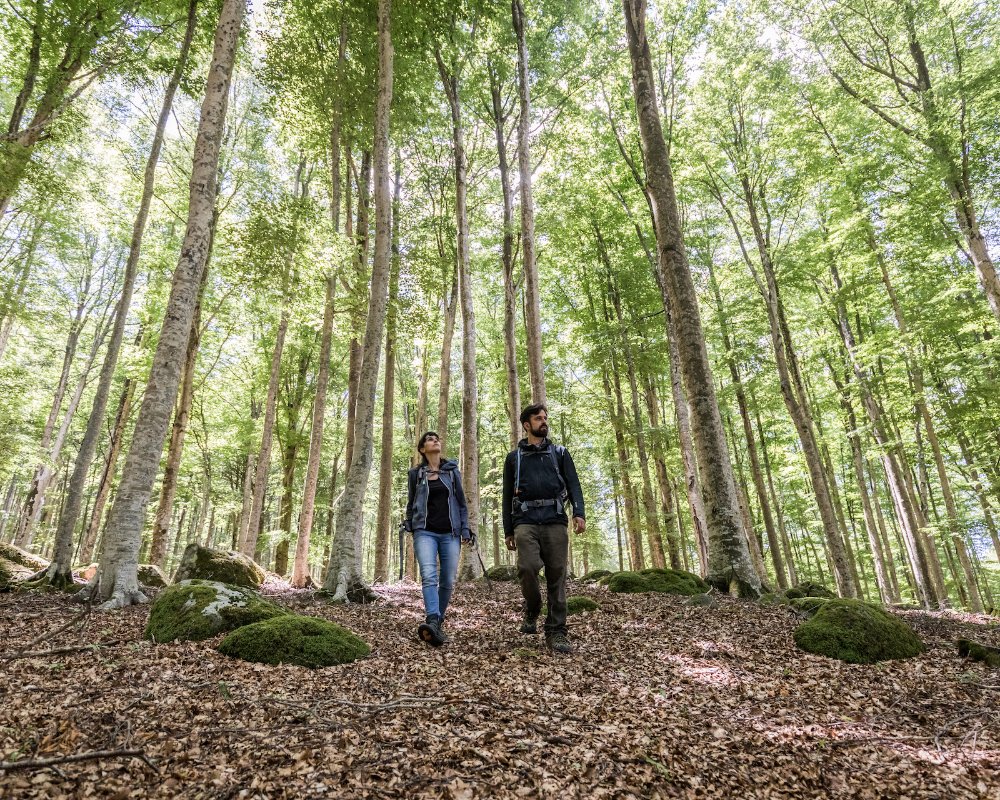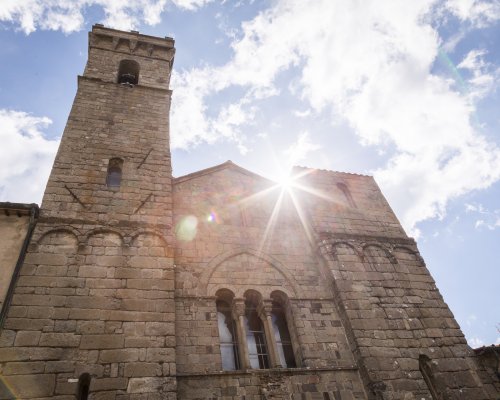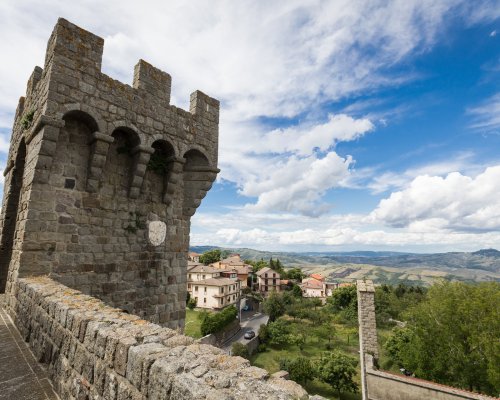Natural reserves, medieval villages, the ancient beech forest and the Monumental Cross
Live 7 days breathing in the scents of nature, including art, genuine flavours and spirituality, in one of the most evocative areas of Tuscany: the ancient sacred mountain of Amiata.
Revered by the Etruscans and Romans, Amiata is a small paradise of biodiversity, ideal for those who love taking long hikes in nature to rediscover themselves.
Follow us on a journey on foot along a circular route of 130 kilometres in 7 stages, until we reach the Cross on the summit of the mountain.
Be aware: the following itinerary requires a minimum of athletic preparation.
Our walking journey to discover Amiata starts from San Salvatore Abbey and the splendid medieval Abbey, a mandatory stop for the pilgrims who walk along the Via Francigena. Here, in the 19th century, Charlemagne stopped, when his army, struck by the plague, was treated by the local monks with medicinal herbs.
We leave the village through the narrow streets of the historic town centre and take the old road, immersing ourselves among the centuries-old chestnut trees of Amiata, to reach the nearby village of Piancastagnaio, famous for its historic centre, divided into 4 districts, and for the splendid Rocca Aldobrandesca. The village dominates the valley and the ascent to the Rocca tower will offer an exceptional view.
We leave Piancastagnaio and enter the Pigelleto and Monte Penna nature reserve which extends for over a thousand hectares. In addition to sighting of wild animals, such as foxes, wild boars, fallow deer and squirrels, the woods of the Reserve also allow us to admire many species of plants, such as the silver fir called Pigello, and accompany us to Castell'Azzara, the last leg of the day.
The historic centre of this village is a real storybook of Mount Amiata for some of the most interesting legends of the mountain, a prelude to a well-deserved rest in one of the many farmhouses surrounding it.
Our walking journey to discover Amiata starts from San Salvatore Abbey and the splendid medieval Abbey, a mandatory stop for the pilgrims who walk along the Via Francigena. Here, in the 19th century, Charlemagne stopped, when his army, struck by the plague, was treated by the local monks with medicinal herbs.
We leave the village through the narrow streets of the historic town centre and take the old road, immersing ourselves among the centuries-old chestnut trees of Amiata, to reach the nearby village of Piancastagnaio, famous for its historic centre, divided into 4 districts, and for the splendid Rocca Aldobrandesca. The village dominates the valley and the ascent to the Rocca tower will offer an exceptional view.
We leave Piancastagnaio and enter the Pigelleto and Monte Penna nature reserve which extends for over a thousand hectares. In addition to sighting of wild animals, such as foxes, wild boars, fallow deer and squirrels, the woods of the Reserve also allow us to admire many species of plants, such as the silver fir called Pigello, and accompany us to Castell'Azzara, the last leg of the day.
The historic centre of this village is a real storybook of Mount Amiata for some of the most interesting legends of the mountain, a prelude to a well-deserved rest in one of the many farmhouses surrounding it.
- straighten
Length25 Km
-
DifficultyDemanding
- schedule
Duration1 day
- trending_down
Descent-1181
- trending_up
Ascent1153
The second leg begins with a guided exploration of the Sassocolato Cave, just outside Castell’Azzara: this suggestive natural cavity is a national treasure that takes its name from the millenary stalactites and stalagmites and hosts a large colony of bats of 12 different species.
Going back to the surface, we resume the journey towards the convent of the Selva, a suggestive church in the middle of a fir forest where many works of art are preserved, including a terracotta from Della Robbia and a skull that, legend has it, even belonged to a dragon.
A short distance away is Santa Fiora, one of the most beautiful villages in Italy: its medieval charm arouses amazement at every corner, with its small squares and cobbled streets. Here water is the absolute protagonist, with the Fiora springs pouring into the splendid Peschiera, a park-garden of idyllic beauty.
Also, a visit to the Robbiane, in the Pieve delle Sante Flora and Lucilla, and to the 16th-century Palazzo Sforza Cesarini overlooking them can't be missed.
The second leg begins with a guided exploration of the Sassocolato Cave, just outside Castell’Azzara: this suggestive natural cavity is a national treasure that takes its name from the millenary stalactites and stalagmites and hosts a large colony of bats of 12 different species.
Going back to the surface, we resume the journey towards the convent of the Selva, a suggestive church in the middle of a fir forest where many works of art are preserved, including a terracotta from Della Robbia and a skull that, legend has it, even belonged to a dragon.
A short distance away is Santa Fiora, one of the most beautiful villages in Italy: its medieval charm arouses amazement at every corner, with its small squares and cobbled streets. Here water is the absolute protagonist, with the Fiora springs pouring into the splendid Peschiera, a park-garden of idyllic beauty.
Also, a visit to the Robbiane, in the Pieve delle Sante Flora and Lucilla, and to the 16th-century Palazzo Sforza Cesarini overlooking them can't be missed.
- straighten
Length22 Km
-
DifficultyDemanding
- schedule
Duration1 day
- trending_down
Descent-939
- trending_up
Ascent833
The third leg of the journey is dedicated to the discovery of nature.
We start from Santa Fiora to cross the alpaca pastures, until we reach the geothermal power plant of Bagnore 4. From here we venture into the splendid Pescinello Nature Reserve, among monumental trees, gigantic maples and centenary lime trees, as well as dogwood and holly, born as if by magic among the stony ground of limestone or solitary in the middle of the pastures, in a fairytale landscape.
We then reach the village of Roccalbegna, which has always been the border and passage between the mountain and the plain. Watching over this delightful medieval village is the Sasso, the imposing rock on the top of which the remains of the ancient Rocca Aldobrandesca are still visible and from where you can enjoy a breathtaking view of the entire Albegna valley. More recent, however, is the Sienese Cassero, today transformed into a delightful garden where you can rest your weary limbs.
The day will end only after a snack based on local cheeses, craft beer and the traditional savoury biscuit from Roccalbegna.
The third leg of the journey is dedicated to the discovery of nature.
We start from Santa Fiora to cross the alpaca pastures, until we reach the geothermal power plant of Bagnore 4. From here we venture into the splendid Pescinello Nature Reserve, among monumental trees, gigantic maples and centenary lime trees, as well as dogwood and holly, born as if by magic among the stony ground of limestone or solitary in the middle of the pastures, in a fairytale landscape.
We then reach the village of Roccalbegna, which has always been the border and passage between the mountain and the plain. Watching over this delightful medieval village is the Sasso, the imposing rock on the top of which the remains of the ancient Rocca Aldobrandesca are still visible and from where you can enjoy a breathtaking view of the entire Albegna valley. More recent, however, is the Sienese Cassero, today transformed into a delightful garden where you can rest your weary limbs.
The day will end only after a snack based on local cheeses, craft beer and the traditional savoury biscuit from Roccalbegna.
- straighten
Length14 Km
-
DifficultyDemanding
- schedule
Duration1 day
- trending_down
Descent-721
- trending_up
Ascent552
A real mystical stage to discover one of the most scenic places of the journey, the Mount Labbro Nature Reserve.
From a height of 1193 m. of the summit of the mountain top, with the barren lunar landscape, here the suggestion of the eye joins the more intimate one of the soul, which has made this a place of worship since the Bronze Age, theatre of the events of the Jurisdavidic community of Davide Lazzaretti, the "prophet of Amiata", up to the Zdog Chen community of Buddhist faith, which today occupies its northern slopes. From the top of the ruins of the Jurisdictional Tower, the gaze is lost between the Apennine mountains and the coast, to the islands of the Tuscan Archipelago Park.
Descending towards the village of Arcidosso, known for the splendid Rocca Aldobrandesca, one of the oldest and best-preserved medieval castles in Amiata, we will continue towards Castel del Piano, a town rich in history with its palaces and churches.
To reach it, we follow the 18th-century Leopoldina road which passes through the delightful Pieve di Lamula, the main religious center of western Amiata between the 9th and 11th centuries and today an ideal place for romantic weddings.
A real mystical stage to discover one of the most scenic places of the journey, the Mount Labbro Nature Reserve.
From a height of 1193 m. of the summit of the mountain top, with the barren lunar landscape, here the suggestion of the eye joins the more intimate one of the soul, which has made this a place of worship since the Bronze Age, theatre of the events of the Jurisdavidic community of Davide Lazzaretti, the "prophet of Amiata", up to the Zdog Chen community of Buddhist faith, which today occupies its northern slopes. From the top of the ruins of the Jurisdictional Tower, the gaze is lost between the Apennine mountains and the coast, to the islands of the Tuscan Archipelago Park.
Descending towards the village of Arcidosso, known for the splendid Rocca Aldobrandesca, one of the oldest and best-preserved medieval castles in Amiata, we will continue towards Castel del Piano, a town rich in history with its palaces and churches.
To reach it, we follow the 18th-century Leopoldina road which passes through the delightful Pieve di Lamula, the main religious center of western Amiata between the 9th and 11th centuries and today an ideal place for romantic weddings.
- straighten
Length20 Km
-
DifficultyDemanding
- schedule
Duration1 day
- trending_up
Ascent-743
- height
Overall altitude difference839
We leave early in the morning to reach the ruins of the Monastery of San Bernardino, successor of Francis of Assisi, crossing a hilly landscape with unique views, surrounded by vineyards and some of the oldest olive trees in the region.
From here we arrive at the hilltop village of Seggiano, famous for its extra virgin olive oil obtained from the Seggianese olive. Do not miss the visit to the Diffused Oil Museum, with the splendid Olivo del Cisternone, the largest specimen of olive tree in the world cultivated with aeroponic technology.
In Seggiano we will also be able to discover the contemporary art with a relaxing walk in the Garden of Daniel Spoerri, a place where art and nature coexist harmoniously thanks to the 113 installations by different artists.
We leave early in the morning to reach the ruins of the Monastery of San Bernardino, successor of Francis of Assisi, crossing a hilly landscape with unique views, surrounded by vineyards and some of the oldest olive trees in the region.
From here we arrive at the hilltop village of Seggiano, famous for its extra virgin olive oil obtained from the Seggianese olive. Do not miss the visit to the Diffused Oil Museum, with the splendid Olivo del Cisternone, the largest specimen of olive tree in the world cultivated with aeroponic technology.
In Seggiano we will also be able to discover the contemporary art with a relaxing walk in the Garden of Daniel Spoerri, a place where art and nature coexist harmoniously thanks to the 113 installations by different artists.
- straighten
Length15 Km
-
DifficultyDemanding
- schedule
Duration1 day
- trending_down
Descent-778
- trending_up
Ascent577
This is the leg that will lead us to the summit of the Amiata.
From Seggiano we leave for a route of 18 kilometers of pure beauty, first through chestnut trees and then exploring the beautiful beech forest. Here, following the marked trails, surrounded by nature it is possible to regenerate our bodies, before reaching the Monumental Cross, the symbol of Amiata, built for the Holy Year, in 1900.
Sitting at the foot of the cross, enjoying the satisfaction of having reached the summit of the mountain, let yourself be lulled by the view of the infinite horizon. During the good days, you will be able to embrace the look of the Tuscan coast to the sea.
Awaiting us for a well-deserved rest is a hearty meal of typical Amiata products in one of the many refuges.
This is the leg that will lead us to the summit of the Amiata.
From Seggiano we leave for a route of 18 kilometers of pure beauty, first through chestnut trees and then exploring the beautiful beech forest. Here, following the marked trails, surrounded by nature it is possible to regenerate our bodies, before reaching the Monumental Cross, the symbol of Amiata, built for the Holy Year, in 1900.
Sitting at the foot of the cross, enjoying the satisfaction of having reached the summit of the mountain, let yourself be lulled by the view of the infinite horizon. During the good days, you will be able to embrace the look of the Tuscan coast to the sea.
Awaiting us for a well-deserved rest is a hearty meal of typical Amiata products in one of the many refuges.
- straighten
Length18 Km
-
DifficultyDemanding
- schedule
Duration1 day
- trending_down
Descent-398
- trending_up
Ascent1659
The alarm clock rings early in the mountain shelters and so we prepare to leave for the last descent that will take us back to Abbadia San Salvatore.
Enjoy the walk through the ancient Beechwood in a real forest bathing, and then a stop to admire the Sasso di Dante, an immense rock whose profile recalls the famous Florentine poet and the Grotta dell'Arciere (access only on request). On the way down to Abbadia, don't miss the Amiata Botanical Garden, where numerous native species of plants from all over the area are collected.
Just outside the Amiata village, we come across the ancient mining hamlet of Abbadia: here, the ovens and warehouses have been transformed into a modern and technological Mining Museum.
The visit to this important site, which between the 19th and 20th centuries contributed enormously to the social development of the territory, closes our grand tour on foot to discover Amiata.
The alarm clock rings early in the mountain shelters and so we prepare to leave for the last descent that will take us back to Abbadia San Salvatore.
Enjoy the walk through the ancient Beechwood in a real forest bathing, and then a stop to admire the Sasso di Dante, an immense rock whose profile recalls the famous Florentine poet and the Grotta dell'Arciere (access only on request). On the way down to Abbadia, don't miss the Amiata Botanical Garden, where numerous native species of plants from all over the area are collected.
Just outside the Amiata village, we come across the ancient mining hamlet of Abbadia: here, the ovens and warehouses have been transformed into a modern and technological Mining Museum.
The visit to this important site, which between the 19th and 20th centuries contributed enormously to the social development of the territory, closes our grand tour on foot to discover Amiata.
- straighten
Length10 Km
-
DifficultyDemanding
- schedule
Duration1 day
- trending_down
Descent-983
- trending_up
Ascent95


